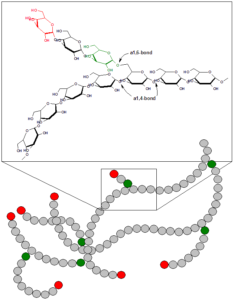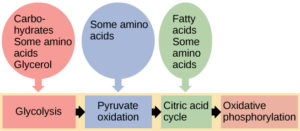50 Metabolism of molecules other than glucose
You have learned about the catabolism of glucose, which provides energy to living cells. But living things consume more than just glucose for food. How does a turkey sandwich, which contains various carbohydrates, lipids, and protein, provide energy to your cells?
Basically, all of these molecules from food are converted into molecules that can enter the cellular respiration pathway somewhere. Some molecules enter at glycolysis, while others enter at the citric acid cycle. This means that all of the catabolic pathways for carbohydrates, proteins, and lipids eventually connect into glycolysis and the citric acid cycle pathways (Figure 1). Metabolic pathways should be thought of as porous—that is, substances enter from other pathways, and other substances leave for other pathways. These pathways are not closed systems. Many of the products in a particular pathway are reactants in other pathways.
Carbohydrates
So far, we have discussed the carbohydrate from which organisms derive the majority of their energy: glucose. Many carbohydrate molecules can be broken down into glucose or otherwise processed into glucose by the body. Glycogen, a polymer of glucose, is a short-term energy storage molecule in animals. When there is plenty of ATP present, the extra glucose is converted into glycogen for storage. Glycogen is made and stored in the liver and muscle. Glycogen will be taken out of storage if blood sugar levels drop. The presence of glycogen in muscle cells as a source of glucose allows ATP to be produced for a longer time during exercise.

Most other carbohydrates enter the cellular respiration pathway during glycolysis. For example, sucrose is a disaccharide made from glucose and fructose bonded together. Sucrose is broken down in the small intestine. The glucose enters the beginning of glycolysis as previously discussed, while fructose can be slightly modified and enter glycolysis at the third step. Lactose, the disaccharide sugar found in milk, can be broken down by lactase enzyme into two smaller sugars: galactose and glucose. Like fructose, galactose can be slightly modified to enter glycolysis.
Because these carbohydrates enter near the beginning of glycolysis, their catabolism (breakdown) produces the same number of ATP molecules as glucose.
Proteins
Proteins are broken down by a variety of enzymes in cells. Most of the time, amino acids are recycled into new proteins and not used as a source of energy. This is because it is more energy efficient to reuse amino acids rather than making new ones from scratch. The body will use protein as a source of energy if:
- There are excess amino acids (you consume more protein than you need)
- The body is in a state of famine (you are starving and have no other source of energy available)
When proteins are used in the cellular respiration pathway, they are first broken down into individual amino acids. The nitrogen atom from each amino acid is removed and is excreted as urea in urine.
After the nitrogen has been removed, each amino acid is converted into a molecule that can enter the citric acid cycle. However, not all of these amino acids enter the citric acid cycle at the beginning. Depending on the chemical structure of the amino acid, it can enter the citric acid cycle in different places.
Lipids
Triglycerides (fats) are a form of long-term energy storage in animals. Triglycerides store about twice as much energy as carbohydrates. Triglycerides are made of glycerol and three fatty acids. Glycerol is a 3-carbon sugar, which enters cellular respiration in the middle of glycolysis. Fatty acids are composed of long chains of carbons. These long carbon chains are broken into two-carbon units (acetyl groups) that enter the citric acid cycle in the same place that acetyl groups generated from pyruvate enter – they are attached to a Coenzyme A and become a molecule of acetyl-CoA. Because there are so many carbons in three fatty acids, and each 2-carbon unit can enter the citric acid cycle, one fatty acid molecule can generate much more ATP than one molecule of glucose.
For example, imagine a triglyceride that is made of a glycerol and three fatty acid chains that each contain 20 carbons. Each fatty acid chain could be broken down into ten 2-carbon acetyl groups, giving us a total of 30 acetyl groups that can enter the citric acid cycle. Compare that to a molecule of glucose that can only be broken down into two acetyl groups (one from each molecule of pyruvate produced at the end of glycolysis). This is how triglycerides store much more energy than carbohydrates!

Remember that if oxygen is not available, glycolysis can occur but not the citric acid cycle or oxidative phosphorylation. Since fatty acids enter the pathway at the citric acid cycle, they can not be broken down in the absence of oxygen. This means that if cells are not performing aerobic cellular respiration, the body can not burn fat for energy. This is why posters about the “Fat Burning Zone” in a gym specify that you need to have a lower heart rate / breathing rate to burn more fat – cells that are not doing aerobic respiration can’t burn fat for fuel!
References
Unless otherwise noted, images on this page are licensed under CC-BY 4.0 by OpenStax.
Text adapted from: OpenStax, Concepts of Biology. OpenStax CNX. May 18, 2016 http://cnx.org/contents/b3c1e1d2-839c-42b0-a314-e119a8aafbdd@9.10

